WHAT'S NEW ACROSS THE WORLD
| What's New ©by
Laif DeMason
Summer is long over and it is time to “get down
to business”! Many cichlid hobbyists will soon start to think and
re-think their fishy set-ups. Seemingly, which cichlid groups are
most popular is dependent upon hobbyists in each country and sometimes
in each part of a country. Often the water characteristics in each
region also contribute towards determining popularity. Hobbyists
want to see their cichlids breed and thus for those in areas that have
naturally soft, acid water, dwarf apistos or Pelvicachromis may fit the
bill. However, many areas of the world where cichlid-keeping is keen
have hard, alkaline water where East African cichlids are king. So
to each his own, and one thing to be sure — cichlid hobbyists are always
willing to try something new!
Here’s “what’s new” on the cichlid scene: |
Lake Tanganyika
The status quo seems to be holding across this area. Collections
and exports are nearly the same as for the last six months or so, as regular
exports continue from Burundi, Zambia, and Tanzania. Occasional collections
from specific areas in Congo are infrequent. Occasionally a new item
appears — or at least one that has not been around lately!
|
what's new: Lake Tanganyika
|

Available from the central Tanzanian coast, Petrochromis
sp. “Ikola” is one of the more colorful forms of the genus and somewhat
reasonably-sized as well. |

Caught near Msalaba, Tanzania, males of Tropheus
sp. “Mpimbwe” sport red cheeks. |

Reportedly from the central Tanzanian coast as well,
this new Tropheus “rainbow special” male is colored similarly to
a reddish “Ilangi”; females are green, as in Ilangis. |

A strain developed some years ago, albino Paracyprichromis
nigripinnis “neon” are still infrequently sold. |
Lake Malawi
The more established exporters around Lake Malawi seem to be holding
strong on sales, whereas the newcomers on the lake seem to be struggling.
More effort has been directed towards uncovering “new” forms to strengthen
interest. Interest in odd and smaller mbunas like Labidochromis
and “dwarf” pseudos such as perspicax types is still evident.
Bred items are plentiful after the recent summer breeding season.

A new variety from the Malawi coast shipped as Aulonocara
sp. “Zunga” has arrived. |

Another steveni type, Protomelas taeniolatus
“Border” has also arrived from the Malawi coastline. |

From Chizumulu Island (Malawi), Labidochromis flavigulus
has piqued some interest in small mbuna fans. Photo by A. Konings. |
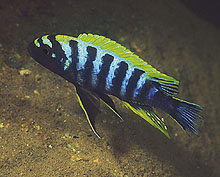
From north of Njambe (Tanzania) comes a new yellow-blaze
Cynotilapia afra variety. Photo by A. Konings. |

Collected from Luhuchi Rocks south of Mbamba Bay (Tanzania),
Pseudotropheus elongatus males sport strong bars typical of “ornatus
type” members of this group. Photo by A. Konings. |
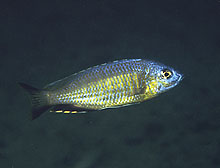
Originally collected near Otter Point in Malawi National
Park, Nyassachromis eucinostomus is available from bred sources. |
West Africa
West African collectors and exporters are active and continue to send
out material. Cichlids from Cameroon, Guinea, Nigeria, and Congo
have all made their appearance. New items are still in big demand and exporters
are trying their best to comply.

A recent new export from Cameroon, Pelvicachromis
taeniatus “Makoure” has made its appearance. |
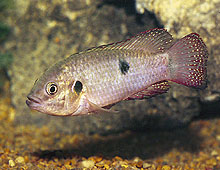
Available from Guinea, Hemichromis letourneaux
is a true jewelfish sporting red and often lime green coloration. |

Often sold as “silver jewelfish”, the actual identity
of this Guinea export is likely to be a tilapiine. |
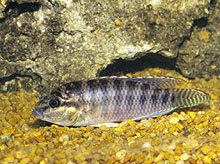
Also seasonally available from Cameroon and not often
seen, Parananochromis caudifasciata has been exported of late. |
Neotropics
Collecting season in South America has started strong with a variety
of pike cichlids and the usual associated species (some not cichlids!).
Also, there are good quantities of bred items like dwarfs, discus, and
the usual ’Cichlasoma’ varieties. Special color morphs of
mid-America species are also actively sought by avid travelers/hobbyists
to be used in further breeding efforts.

One of the many bred dwarf cichlids from Europe, Apistogramma
sp. “opal” is a popular choice. Photo by A. Konings. |
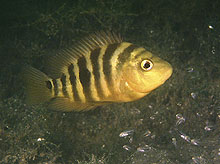
Now produced by specialty breeders, this yellow Amphilophus
amarillo originally comes from Lake Xiloá in Nicaragua. Photo
by A. Konings. |
|















